Interview with ‘Brunch’ director Marnik Loysen
Avocados, anxiety and the generational divide cumulate in this bold and stylish new short film by Marnik Loysen. In recent years the humble avocado has been weaponised as a symbol of the ‘haves’ and ‘have-nots’, the increasing level of division between the economic elite and ageing millennials. Brunch highlights the pressures of living up to the social norms of the previous generation, whilst also dealing with an ever-fluctuating economic landscape and ever-deteriorating environment that is having an increasingly devastating global effect. “When are you going to settle down and have children?” “Are you ever going to get on the housing ladder?” “When are you going to a ‘real’ job anyway?” – it’s enough to make you want to blow it all on a single, decadent brunch.
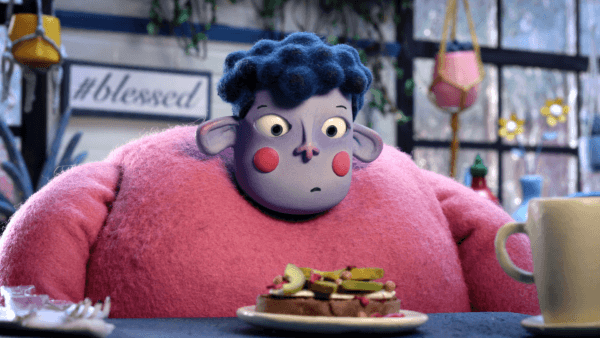
Brunch (dir. Marnik Loysen)
The dichotomies and in-fighting within our community are packed deliciously into this short stop-motion film. The bold puppets’ design and level of detail given to the backgrounds create a perfect homage to everything that has come to signify the current popular culture, from the reproduction prints of botanical illustrations to painted industrial brick walls, hacked IKEA furniture, house plants, hashtags and the never-ending options for a bespoke coffee order that infuriate the old, humiliate the young but are ultimately humourous in their utter frivolity when compared to the real issues that orbit and impact us all.
We were lucky enough to catch some time with Marnik as the film begins its festival journey, having premiered this month at 2021 Encounters Film Festival.
Can you start by telling me a little bit about yourself and how you started working in animation?
I went to university in 2015 to study animation, but quickly found that it wasn’t really the right place for me. So, I was looking for ways out and managed to get a job at Aardman on Early Man as an assistant animator and I have been there ever since on all their feature films, TV specials and series. I have also been trying to make my own stuff in the gaps between projects at Aardman. That’s really the aim, to try and find a balance between working on my own stuff and getting paid. Which recently has been a good balance, but we’ll see, it’s always difficult.
Can you describe the idea behind Brunch, was it inspired by a particular event? Or was it a combination of research on the subject?
Brunch is about generational divisions and millennials eating too many avocados. It’s come up in so many discussions over the last few years. Obviously, it kind of began with that Australian billionaire who was talking about how millennials can’t afford homes because they spend all their money on avocados, which then became a meme, both online and in the real world. It just kept coming up and I really thought it was a funny thing, that people were talking about it so much but also that it does have a lot of real-world consequences and interacts with so much of the social discussion that’s happening at the moment. So really, it just came from those conversations and thinking about everything that it connects to. It was originally just a very silly idea but when I actually developed it into film, I started realising that every story that was in the news was linked to this idea of generational division. In the end it ended up being quite difficult, trying to work out what to actually put in, because it could have gone on for hours, developing a script about everything that is being discussed and how it’s linked to.
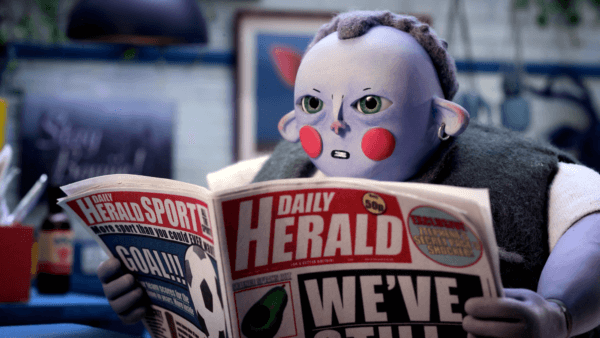
Brunch (dir. Marnik Loysen)
Can you tell me a little bit about the circumstances that led to the film’s production? Did you get much support, funding-wise?
We were trying to get funding the whole way through. Unfortunately, it never happened. I think it was made harder by not having a great deal of my own past work to show. But it was a good script and I knew we could make something good, but I couldn’t prove that in any way. Also, the producer hadn’t worked on an animated film before, which probably led to the same issue in the funders’ minds. In the end, it was just me and the producer Simon Marriott who self-funded it – which, to be honest, I probably can’t do again. It did give us some great opportunities, because although we were limited by what we could afford, we also didn’t have any other voices or parties we had to consider, so we were really able to make it the way we wanted to make it. I’ve worked with funding bodies before where the film has ended up not being quite what I wanted because there were other voices involved.
I understand that you made this pretty much in the height of the pandemic, how did you have to adapt to keep the project moving forward?
The pandemic was, in a way, a blessing at the start, because I probably wouldn’t have made the film without the furlough in the first lockdown. I know for a lot of people that wasn’t the case and they didn’t have that kind of experience. I had lots of creative energy and really wanted to make stuff, so I got to put it into lots of art. A lot of it was developing this film, writing the script, developing the character work and everything. So that was kind of great because there are not many opportunities in your life where you have the time to actually do that, to sit back and let it happen. But then when it came to the actual production it was almost a bit of a nightmare because, two days before I was going to move everything into the studio, we went into the January lockdown. So I thought it was just dead. I thought “that’s it, we’re not going to be able to make it”. In reality, it just came down to a bit more organisation. The crew were absolutely amazing, which is what made it work.
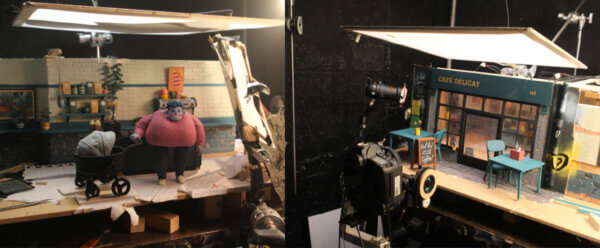
Image via Marnik Loysen
We just decided that only people who had to go into the studio would go into the studio, by avoiding people and working from home and then delivering stuff to each other when needed. Daniel Morgan, who was the cinematographer, managed to do all his work via zoom. I would share my screen with him and between the live feed from the camera, the webcam from the computer (which would allow him to see me on set), my phone on a tripod looking down at the set from above and another camera if we had one available, he would have a bunch of different angles of the set. And he could just instruct me on where to put the lights. We’d work it out together like that, which I thought was a bit disappointing, but turned out to be absolutely great. He was amazing. So yeah, I couldn’t be happier with the end result.
As with most short films, it’s a real labour of love and often members of the crew wear many hats. As writer/director how involved were you with the puppets and the animation?
Ellie Palmer, an amazing puppet maker at Aardman, helped out with the puppets. All of the designs and everything that’s sculpted was done by me. She worked from the designs and blueprints – so the moulding, casting, paintwork and the fabric work, that kind of thing. The puppets ended up looking so amazing and I’m so thankful. And the animation was all me. I would have liked to hire an animator if I could afford it but I had to do it myself.
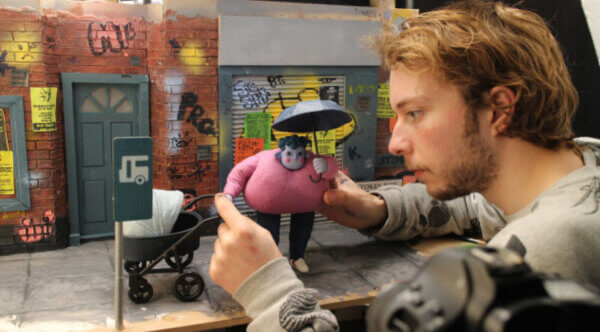
Image via Marnik Loysen
The style of the characters is very bold and very impactful. They’re also quite unique. I don’t think I’ve seen characters that are like them anywhere. What was your process for developing the look of the film?
Thank you, I’m very glad you think that about the design. I think it’s always really important to me. Particularly with this, it was so involved with the idea and the look of it from the very beginning, it had to in essence look sort of like a hipster’s ultimate dream, but then turned up to 11, a little bit further, until it gets a bit wonky and a bit weird. So all of the colours and everything that fills the frames led to that, essentially. Like with any design work, there were just lots of iterations and workings, trying extreme things and seeing what worked and then seeing like a version further until they go too far. And making sure that everything was kind of designed from the same point of view, so it all fits together on the screen.
It kind of reminds me of a comment I saw on Twitter in which someone was complaining that all animation looked a particular way – they didn’t like this particular thin-lined, modern, very flat 2D aesthetic that is currently dominating commercials, such as Robert Strange’s Mini Cheddars – Cheddar Town series. Brunch kind of looks like a 3D version of that, but that argument of “I’m so sick of everything looking a certain way” I can’t really get behind.
The style you’re describing was literally one of the main starting points in my mind. It was just a case of working out “how do you do that in stop motion?” – because, obviously, there are limitations. You can’t just do exactly the same thing. But it all came from a bunch of designs, I did have certain shots that had a really specific looked to them. But I would keep asking myself how I can push it to its extreme, make it look like a piece of 2D artwork. Also, lots of the inspiration came from children’s illustrations and graphic novels as much as possible, really contemporary stuff. The idea is really meant to fit into that world of what’s happening in the main characters, basically.
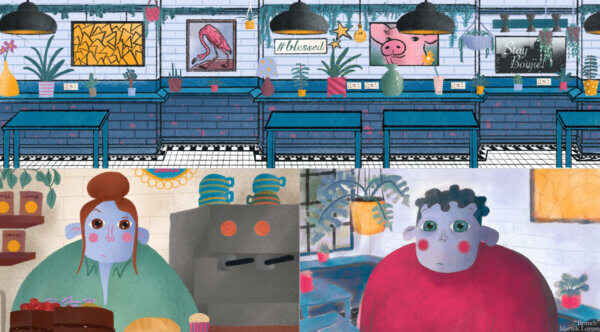
Image via Marnik Loysen
I like animation that really comes from an illustration position. One of my favourite things in the film were the credits, which is not to say I don’t really like the rest of the film. I just haven’t seen really nice end credits for a long time, that aren’t just black or white but something different that sort of ties the whole film together.
It’s like what I was saying earlier about the idea of millennials and the generational divides. Once you start thinking about it, you can work out how to make everything apply to that. So even in the credits and bits of artwork hung up in the background, it is all connected to that. I’m lucky to have found an idea like that, that really didn’t require too much thought because it all just fit together really nicely and easily.
I find it interesting because the film also has a very art school aesthetic, which is interesting – especially as you didn’t go down that route yourself in the end. I feel like this film is what you probably would have wanted to aim for if you’d gone through with a degree. So you’ve kind of done that but also kickstarted your career as well, which is ideal really.
Yeah, totally. Literally, out of all the other things I’ve made prior to this, this is the first one that’s kind of ended up being what it was meant to be, you know and there’s some ineffable quality that I can see, that I wanted for all of my work from the start, but this is the only one that’s actually got it. So yes, it’s very gratifying to get to that point.
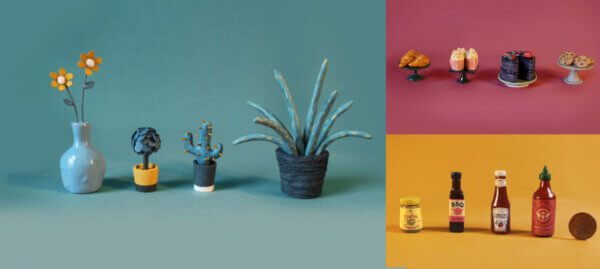
Image via Marnik Loysen
I think especially in the UK, it’s a very unique thing to have been able to make a film that hasn’t gone through one of the big art schools but still ended up as a really strong piece. I think that comes from you being very talented of course, but also having the contacts that you need to bring that together and just being a very affable person as well, which is how you would hope more short films were being made. But it’s a very, very tricky industry in that sense, that often everything has to come together into a perfect storm.
Yeah, I definitely agree with that. And also, you know, it’s fair to say that so much of it does come down to money, which is a really sad thing to say. But part of the reason why this film worked is that I could find great people to work on it, who I knew would be brilliant. And they all had the same perspective that I did and knew what I was going for. Obviously, I don’t know how to light things that well, and I don’t know how to do sound that well. I know the basics of those things but it’s never going to end up looking really polished, as you said, unless you can afford to pay people to do it. Unfortunately, that’s kind of the sad truth about it.
The film has basically only just been completed and is about to go into encounters. Do you have any plans for some now that it’s out there? And has it gotten too many more festivals that you are particularly excited about?
Encounters is the world premiere. So that’s the first one. It’s been sent off to lots of places I can’t talk about anything else yet. So, we’ll see. I’m really hoping that it’s going to get a good reception and get into lots of places because after you’ve put that much work in, you really want lots of people to see it. I really do believe that film festivals are the right setting to watch those kinds of films, with no idea what to expect. It just pops up. And I think that’s the way to enjoy it.
Encounters passholders can see Brunch as part of The Body Politic and Comedy 2 programmes until the end of the month
See more of the work of Marnik Loyson at marnikloyson.com

